Tune Measurements as a Function of Beam Position
in the Superconducting Wigglers
Analysis of Data Taken 18-20 August 2003
21 August 2003
JAC
The measurements labelled "14EA" were taken with wiggler 14EA (WIG1_14E in CESRV, Serial Nr 2) excited to 21 kG. The measurements labelled "14EB" were taken with both wigglers 14EA and 14EB excited to 21 kG with the same polarity. Measurements labelled "19EB_HBUMP_A" were recorded with the two wigglers 14EB and 14EA at 21kG, but wiggler 19EB off. They serve as reference for the succeeding measurements with 19EB excited.
Description of the Analysis
On August 18, tune measurements vs vertical bumps 60 and 61 were
recorded in data file W14EA3_VERT. Immediately thereafter, tune
measurements versus horizontal bumps 72 and 73 were recorded
in W14EA4_HBUMP, while recording phase measurements. Then
tunes versus the vertical bumps were repeated (W14EA_VBUMP) in order to record
phase measurements, which had been omitted earlier. These repeated tune measurements agree with the values previously obtained, as shown in the first
two plots.
The vertical and horizontal bump coefficients
were stored in BIGGRP 91089. The lattice WIG1_14E21KG_T_OPT
was loaded during these measurements. Vertical orbits with the
vertical bumps at zero and 500cu were 92882 and 92883.
The corresponding orbits for the horizontal bumps were 92890 and 92891.
In the following plots, the tune measurements are shown in red.
They are compared to values calculated from the transfer functions
calculated by the Vector Fields tracking algorithm applied to
its own finite-element calculation of the wiggler field (w7-20_26.tracks).
These calculations are shown in green.
The vertical betatron frequency shift as a function
of vertical position shows the cubic nonlinearity
in the transfer function and is calculated as
Del f = f_0 * betay/4pi * dthetay/dy. A fit to the transfer function
thetay vs y shows very small quadratic and quartic terms, leaving only
the cubic term to give a y dependence of the vertical tune.
Similar calculations give the horizontal tune change and the
horizontal dependences of the tune changes. The beta functions
for this lattice and biggrp at the center of WIG14EA (WIG1_14E
in CESRV) are betax=15.0m and betay=31.3m. According to CESRV,
they vary by less than 5% for the bump amplitude ranges of the
measurements. f_0 is 390 kHz.
CESRV calculations of the expected tune shift are shown in blue
in these plots. These results were obtained for W14EA4_VBUMP
with the following commands in CESRV:
*l:WIG1_14E_21KG_T_OPT
*read big 91089
*read o:92882
*run (fit model to reference orbit using all vertical steerings)
*cha sex 82 @0cu (repeat to turn off all sextupoles 11e:17e)
*q_t @216.05 242.5 (set the tunes to the measured zero-bump values)
*read o:92883 (read the orbit taken with vbumps 60,61 set to 500cu)
*veto vert all
*use gr vbump 60:61
*run (fit this orbit using only vbumps 60,61)
*show tune (get CESRV tune calculation for plot comparison)
Fitting to this orbit, CESRV finds bump settings for 60 and 61 of
347 and 442 cu. This is an indication that something isn't quite
right, since the actual set values were 500cu.
Also, setting CESRV to the values 500cu shows a bump
which is not well closed.
The remaining points on the CESRV curve are obtained by scaling
the values 347,442 according to the set values of the measurement.
The comparison shows that the measured tune shifts are much greater
than those calculated from the transfer functions and CESRV, which
agree with each other. This may be due to a mistake in the bump
calibration arising from hysteretic effects during the calculation
of coefficients. The same coefficients were used for the two
vertical bump measurements. The measurements and calculation
agree very well if the bump calibration is changed from 1.20cm/1000cu
to 0.90cm/1000cu.
Another indication that the bump calibration may be wrong is obtained
by comparison to the measurements of tune shift with both 7-pole
wigglers on made by ST on 21 August. In this two-wiggler lattice,
the vertical beta functions at the wigglers
were 29m and 22m. The transfer functions
for a single wiggler with beta=31m give a tune shift of 5.7 kHz.
Scaling with the beta functions and adding the focussing effects
of the two wigglers at Y=1cm, one would expect a shift of 9 kHz, similar
to the measured value of 8 kHz. However, if one uses the single-wiggler
value of 7.5 kHz obtained from measurement, one would get at value
of 12kHz, differing substantially from the observed value.
A tentative conclusion is that the vertical bump calibration was wrong by
25% on 18 August.
The third plot shows the comparisons for the horizontal bump.
The transfer function cannot account for the vertical tune shift
observed. However, since we know from magnetic measurement that
the 7-pole magnets show a linear component (skew quad) which the
Vector Fields calculation does not emulate, we cannot be surprised
that there is also a discrepancy in second order.
Since the horizontal tune shift is not symmetric in the 7-pole wiggler,
the biggest tune shift being on the side where the wiggle occurs,
this measurement is sensitive to the polarity of the wiggler field.
Measurement shows this to be the side of positive HBUMP, which
is negative X (the inside of the CESR ring). This corresponds
to the end-pole field pointing up in the 7-pole wiggler. (A positron
entering the wiggler from the north makes a right turn toward
negative x when entering.)
The transfer function result for 1.8 GeV ELECTRONS shows the big
tune shift to be on the +x side, in agreement with observation in CESR.
(However, there appears to be a bump amplitude calibration problem
here as well as for the vertical bump noted above.)
The tentative conclusion is that the end-pole field is pointing
up in both the Vector Fields model and in CESR (NB: A sign mistake
was made during my presentation of 9/4, when I incorrectly claimed
that the end-pole field points down in the VF calculation). However, this
result is preliminary and still under discussion. It disagrees with
the result using the two 7-pole wiggler cluster measurements of
21 August, which appear to show that CESRV wigglers have opposite
polarity from the wigglers in CESRV using this same technique.
(Note, however, that CESRV does not give conclusive results for this
simpler single-wiggler case, as described below.) One possible resolution
of this discrepancy would be a sign change during the generation of
the Taylor map.
The CESRV calculation shown in this third plot is inconclusive, since it does not show the expected lack of symmetry.
Possibly this is due to the order-3 Taylor
map used in the tracking not being of sufficient accuracy to model
this fairly small effect in the transfer function.
Analysis of the 8-pole wiggler measurements of 19 August has not
yet been completed. However, it is already clear that the bump
calibration will be unknown, since the bump coefficients were not
stored in a biggrp and the calibration orbits were taken at bump
settings which differed from those used during the scan. In particular,
the values used during the scan were incorrect, since they
were the same as those used before the wiggler was turned on
and the bump coefficients recalculated.
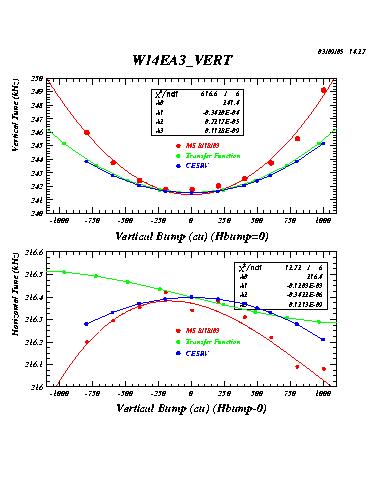
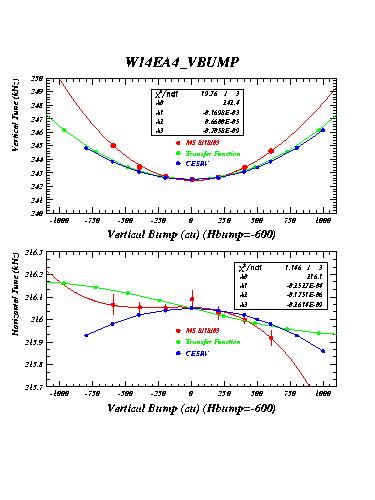
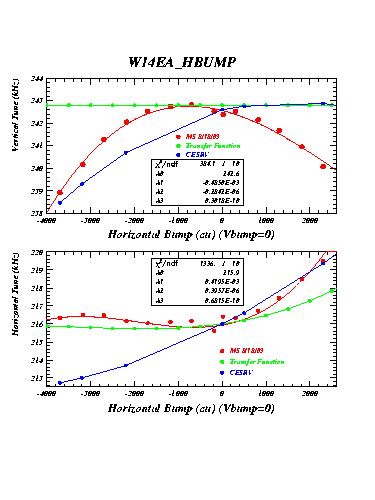
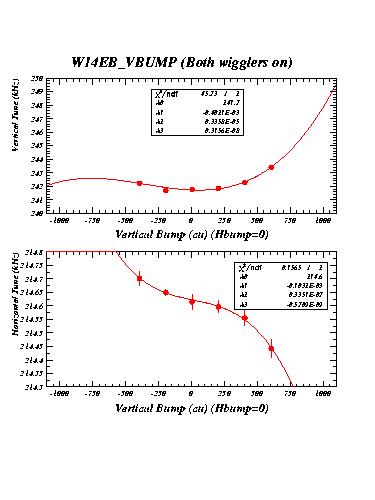
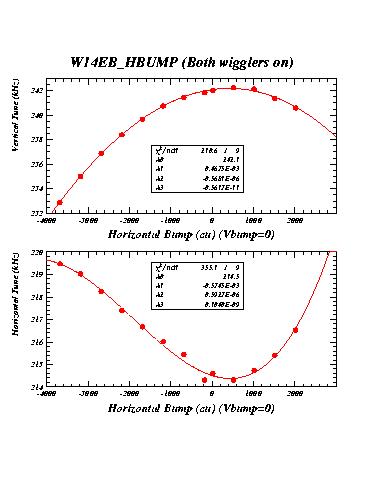
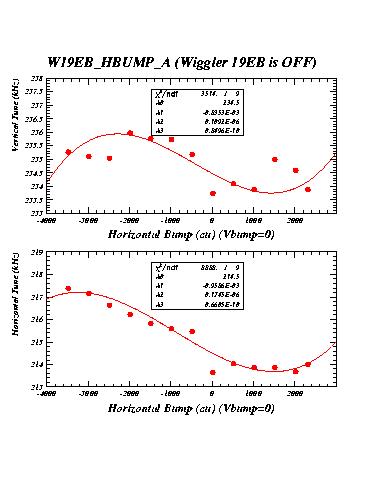
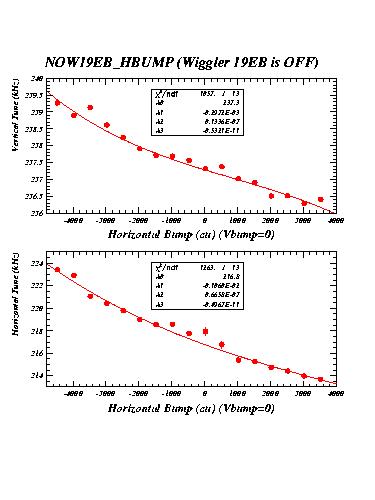
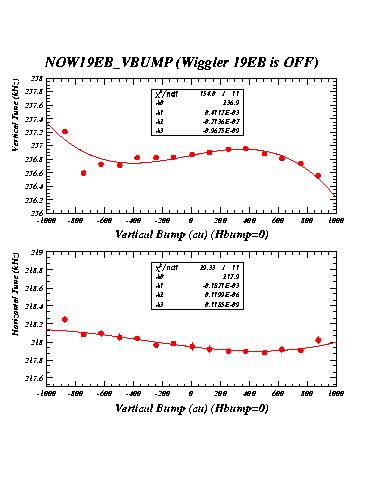
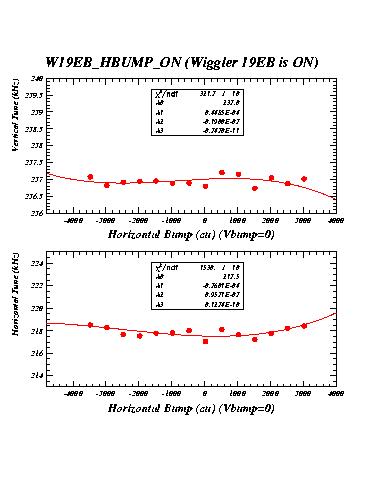
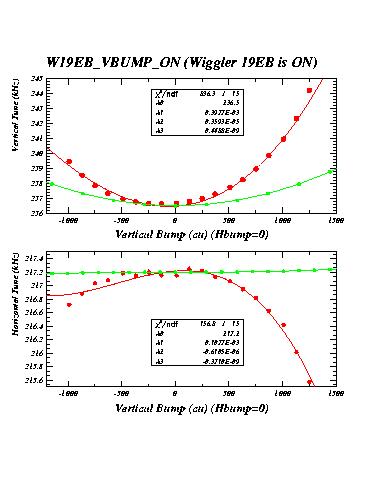
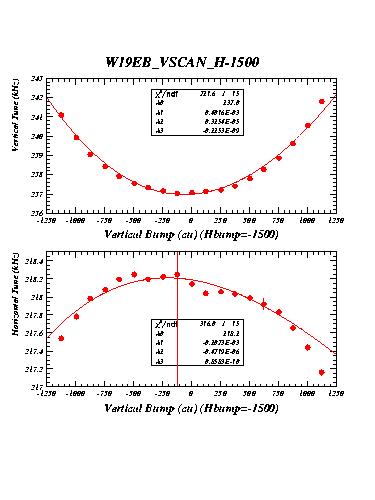
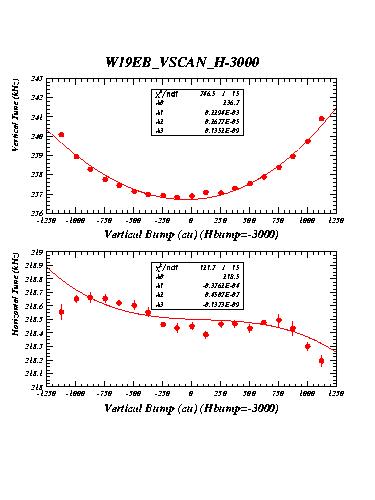
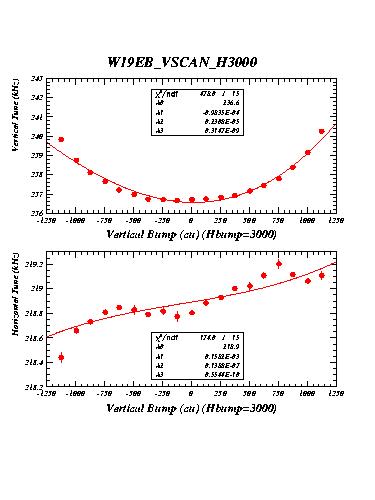
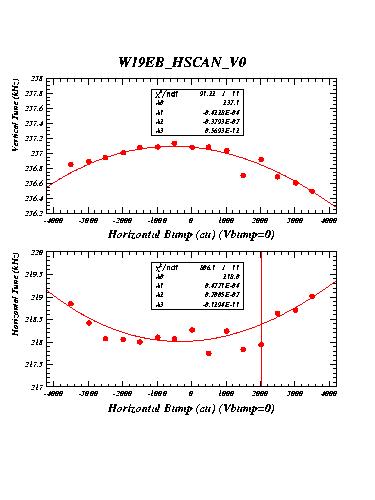
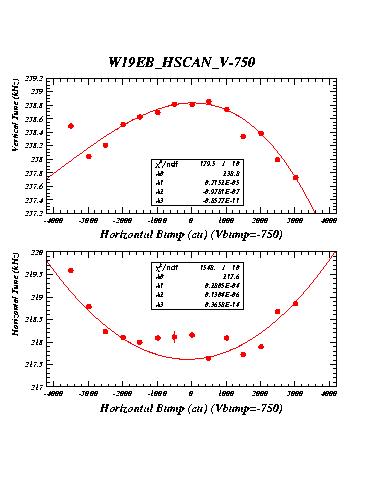
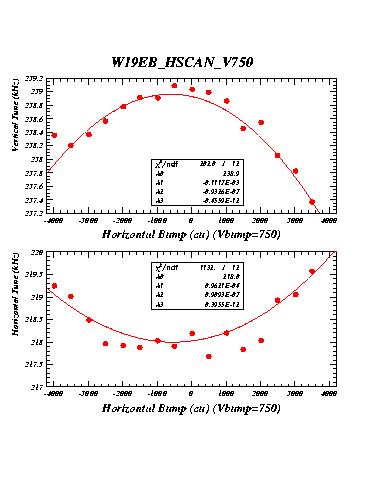
Creation date: 09/05/03.















